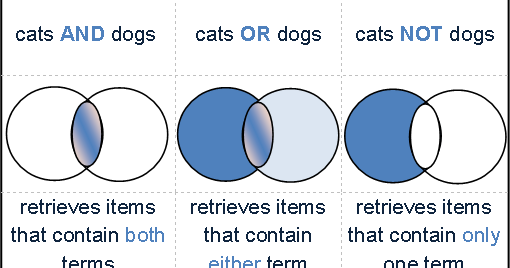
However, the operators that can be used in LinkedIn and Google differ slightly – I’ll point out these differences as and when they come up. These strings can also be used in Google (and are especially useful for setting up Google Alerts) which means you can find relevant content quickly and easily.
#BOOLEAN SEARCH AND HOW TO#
The purpose of this blog is to cover the basics to help you get started and give you some examples of how to build a Boolean search string. Which means for example, if you search in the ‘Job Title’ field in SN using a keyword, it’ll only show results for people that have that keyword in their job title on LinkedIn, where as if you do a Boolean search you will see results of people that mention that keyword anywhere on their profile.īoolean searches can get quite complex and there are lots of combinations and ways you can use the operators (we’ll get on to those shortly) to find what you’re looking for. Well, yes you do get much more powerful searching capabilities in SN, however the filters only search those specific fields, whereas a Boolean strings will search people’s entire profiles for the keyword or words you specify. But if you do have it, surely you can just use their much more extensive filters to easily find people, right? If you don’t have Sales Navigator, Boolean searches are still a far more efficient way of finding relevant people/ prospects.

Not only this, when using the strings in Sales Navigator you can combine them with the other search criteria SN gives you, for example you can use Boolean searches in the ‘job title’ field, but also you can combine a Boolean search with their existing filter options – for example you could filter by industry first, then search these results using a Boolean string to really refine you search and pull up results for specific people within this industry.

They can be used in ‘standard’ LinkedIn but also in Sales Navigator where generally they tend to be more reliable. When done correctly, it opens up a whole new world of prospects and insights.īoolean search strings allow you to perform complex and targeted searches in LinkedIn, they help you to be more organised with your searching and will give you far more accurate results than any other way of searching. Most job boards will recognize the asterisk, but not all search engines do.Īdmin* = administration, administrator, administer, administered, etc.If you’re not doing Boolean searches on LinkedIn you’re missing a secret weapon in social selling. The asterisk is a time-saver so you don't have to write out long, complicated search terms. The asterisk can be used for a root word, stem, or truncation.

#BOOLEAN SEARCH AND SOFTWARE#
The example given returns results that contain both software engineer and software architect. The keyword(s) within the parenthesis will be given priority. Parenthesis can be used to combine other Operators for a more complex search. Any result that has the search option you excluded will not show up in your results. Placing NOT between your search keywords excludes the term after NOT from your search. Placing OR between your search keywords or terms will broaden your search results by returning all possible combinations of your search terms. Placing AND between your keywords will return results that only include both or all your keywords.

Without the quotes, your search engine may return all results that contain each separate word. Placing quotation marks around a search term or phrase limits your search to that exact term or phrase.


 0 kommentar(er)
0 kommentar(er)
